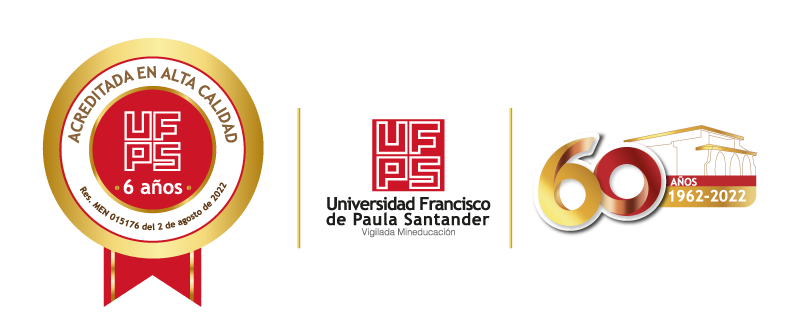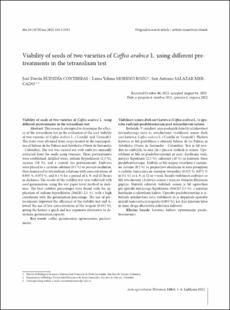Mostrar el registro sencillo del ítem
Viability of seeds of two varieties of Coffea arabica L. using different pretreatments in the tetrazolium test
| dc.contributor.author | BUENDIA CONTRERAS, JOSE DUVAN | |
| dc.contributor.author | Moreno Rozo, laura Yolima | |
| dc.contributor.author | SALAZAR MERCADO, SEIR ANTONIO | |
| dc.date.accessioned | 2024-04-22T14:10:45Z | |
| dc.date.available | 2024-04-22T14:10:45Z | |
| dc.date.issued | 2023-10-13 | |
| dc.identifier.uri | https://repositorio.ufps.edu.co/handle/ufps/6990 | |
| dc.description.abstract | This research attempted to determine the efficacy of the tetrazolium test in the evaluation of the seed viability of two varieties of Coffea arabica L. (‘Castillo’ and ‘Cenicafé’). The fruits were obtained from crops located in the municipalities of Salazar de las Palmas and Arboledas (Norte de Santander - Colombia). The test was carried out with embryos manually extracted from the seeds using tweezers. Three pretreatments were established: distilled water, sodium hypochlorite (2.5 %), sucrose (10 %), and a control (no pretreatment). Embryos were placed in a cysteine solution (0.5 %) to prevent oxidation, then immersed in tetrazolium solutions with concentrations of 0.035 %, 0.075 %, and 0.1 % for a period of 6, 9, and 12 hours in darkness. The results of the viability test were validated with seed germination, using the wet paper towel method in darkness. The best viability percentages were found with the application of sodium hypochlorite (NaClO 2.5 %), with a high correlation with the germination percentage. The use of pretreatments improved the efficiency of the viability test and allowed the use of low concentrations of the reagent (0.035 %), giving the farmer a quick and less expensive alternative to determine germination capacity. | eng |
| dc.format.extent | 6 Páginas | spa |
| dc.format.mimetype | application/pdf | spa |
| dc.language.iso | eng | spa |
| dc.publisher | Acta Agriculturae Slovenica | spa |
| dc.relation.ispartof | Acta agriculturae Slovenica, 118/3, 1–6, Ljubljana 2022doi:10.14720/aas.2022.118.3.2363 | |
| dc.rights | Está bajo una licencia Creative Commons Atribución 4.0 Internacional (CC BY 4.0). | eng |
| dc.rights.uri | https://creativecommons.org/licenses/by/4.0/ | spa |
| dc.source | https://www.dlib.si/details/URN:NBN:SI:DOC-NI9JM7DD/?query=%27contributor%3DBuend%C3%ADa+Contreras%2C+Jos%C3%A9+Duv%C3%A1n%27&pageSize=25 | spa |
| dc.title | Viability of seeds of two varieties of Coffea arabica L. using different pretreatments in the tetrazolium test | eng |
| dc.type | Artículo de revista | spa |
| dcterms.references | Arcila P, J.; Farfan V., F.; Moreno B., A.M.; Salazar G., L.F.; Hincapié G., E. (2007). Sistemas de producción de café en Colombia. Chinchiná, Centro Nacional de Investigaciones en Café (CENICAFE) 309 p. Disponible en https://www. cenicafe.org/es/publications/sistemas_de_produccion.pdf | spa |
| dcterms.references | Arvy, M. P.; Gallouin, F.; Ubillos, M. Á. M. y Montalbán, J. M. (2007). Especias, aromatizantes y condimentos. MundiPrensa, p. 77. Disponible en https://books.google.com. gt/books/about/Especias_aromatizantes_y_condimentos. html?id=yR9R2SBJlQ0C | spa |
| dcterms.references | Aissaoui, M., Rahmoun, N. M., Barek, S., Bensouici, C., & El Haci, I. A. (2020). Structural characterization of phenolic content, antioxidant and antibacterial activities of Coffea arabica green seeds. Vegetos, 33(3), 466-474. https://doi. org/10.1007/s42535-020-00130-9 | spa |
| dcterms.references | Azofeifa-Delgado, L. (2008). Problemas de oxidación y oscurecimiento de explantes cultivados in vitro. Agronomía Mesoamericana, 20(1), 153. https://doi.org/10.15517/ am.v20i1.4990 | spa |
| dcterms.references | Bello Ramírez, L. A., Daza Hernández, D. C., Forero Sarmiento, J. E., Linares Bautista, M. Ángel, & Lesmes Vesga, R. A. (2017). Evaluación de tratamientos pre-germinativos en semillas de café (Coffea arabica L.) variedad Castillo. Revista Sennova: Revista Del Sistema De Ciencia, Tecnología E Innovación, 2(1), 136–161. | spa |
| dcterms.references | Carvalho, T., Ribeiro, C., Castro, O. & Panobianco, M. (2014). Adaptation of the tetrazolium test method for estimating the viability of sorghum seeds. Journal of Seed Science, 36, 246-252. https://doi.org/10.1590/2317-1545v32n2713 | spa |
| dcterms.references | Clemente, A. D. C. S., Carvalho, M. L. M. D., Guimarães, R. M., & Zeviani, W. M. (2011). Preparo das sementes de café para avaliação da viabilidade pelo teste de tetrazólio. Revista Brasileira de Sementes, 33, 38-44. https://doi.org/10.1590/ S0101-31222011000100004 | spa |
| dcterms.references | Clemente, A. D. C. S., Carvalho, M. L. M. D., & Guimarães, R. M. (2012). Suitability of the tetrazolium test methodology for recently harvested and stored coffee seeds. Ciência e Agrotecnologia 36, 415-423. https://doi.org/10.1590/S1413- 70542012000400005 | spa |
| dcterms.references | Da Rosa, S. D. V. F., McDonald, M. B., Veiga, A. D., Vilela, F. D. L., & Ferreira, I. A. (2010). Staging coffee seedling growth: a rationale for shortening the coffee seed germination test. Seed Science and Technology, 38(2), 421-431. https://doi. org/10.15258/sst.2010.38.2.15 | spa |
| dcterms.references | Da Silva, C. Q., da Silva Fernandes, A., Teixeira, G. F., França, R. J., da Costa Marques, M. R., Felzenszwalb, I., .. & Ferraz, E. R. A. (2021). Risk assessment of coffees of different qualities and degrees of roasting. Food Research International, 141, 110089. https://doi.org/10.1016/j.foodres.2020.110089 | spa |
| dcterms.references | França-Neto, J. D. B., & Krzyzanowski, F. C. (2019). Tetrazolium: an important test for physiological seed quality evalu- 6 Acta agriculturae Slovenica, ation. Journal of Seed Science, 41(3), 359-366. https://doi. org/10.1590/2317-1545v41n3223104 | spa |
| dcterms.references | Fantazzini, T. B., Franco da Rosa, S. D. V., Carvalho, G. R., Liska, G. R., de Carvalho, M. L. M., Coelho, S. V. B., ... & Ribeiro, F. A. S. (2020). Correlation between historical data of the germination test and of the tetrazolium test in coffee seeds by GAMLSS. Seed Science and Technology, 48(2), 179- 188. https://doi.org/10.15258/sst.2020.48.2.05 | spa |
| dcterms.references | Figueiredo, M.A., Coelho, S.V.B., Rosa, S.D.V.F., Vilela, A.L. and Silva, L.C. (2017). Exploratory studies for cryopreservation of Coffea arabica L. seeds. Journal of Seed Science, 39, 150- 158. http://doi.org/10.1590/2317-1545v39n2171123 | spa |
| dcterms.references | Hosomi ST, de Souza TB, Custódio CC, Neto NBM (2017) Refining the tetrazolium test for evaluation of Cattleya labiata and C. tigrina seeds viability. Australian Journal of Crop Science, 11(10), 1320-1326. https://doi.org/10.21475/ ajcs.17.11.10.pne606 | spa |
| dcterms.references | Hosomi, S.T., Cust_odio, C.C., Seaton, P.T., Marks, T.R., Barbosa, N.M.N. (2012). Improved assessment of viability and germination of Cattleya (Orchidaceae) seeds following storage. In Vitro Cellular & Developmental Biology Plant, 48, 127–136. https://doi.org/10.1007/s11627-011-9404-1 | spa |
| dcterms.references | Jiang, H., Chen, M. & Lee, Y. (2017). In vitro germination and low-temperature seed storage of Cypripedium lentiginosum P. J. Cribb & S.C. Chen, a rare and endangered lady’s slipper orchid. Scientia Horticulturae, 225, 471-479. https://doi. org/10.1016/j.scienta.2017.07.040 | spa |
| dcterms.references | Khochapong, W., Ketnawa, S., Ogawa, Y., & Punbusayakul, N. (2021). Effect of in vitro digestion on bioactive compounds, antioxidant and antimicrobial activities of coffee (Coffea arabica L.) pulp aqueous extract. Food Chemistry, 348, 129094. https://doi.org/10.1016/j.foodchem.2021.129094 | spa |
| dcterms.references | Lamarca, E. V., & Barbedo, C. J. (2014). Methodology of the tetrazolium test for assessing the viability of seeds of Eugenia brasiliensis Lam., Eugenia uniora L. and Eugenia pyriformis Cambess. Journal of Seed Science, 36(4), 427-434. http://doi.org/10.1590/2317-1545v36n41029 | spa |
| dcterms.references | Medeiros, A. P. S. R., Mendoça, A. F. J., Barros, S. T., Nogueira, N. W., & Oliveira, R. M. F. (2015). Teste de tetrazólio para avaliação da qualidade siológica de sementes de Vigna unguiculata (L.) Walp. Revista Ciência Agronômica, 46(3), 638-644. http://doi.org/10.5935/1806-6690.20150048 | spa |
| dcterms.references | Mercado, S., Caleño, J., and Rozo, L. (2020). Improvement of the methodology of the tetrazolium test using different pretreatments in seeds of the genus Epidendrum (Orchidaceae). Journal of Seed Science, 42, e202042013. https:// doi.org/10.1590/2317-1545v42231028 | spa |
| dcterms.references | Mercado, S. A. S., & Jaimes, Y. M. O. (2022). Implementation of organic components to the culture medium to improve the in vitro propagation of Cattleya warscewiczii and Cattleya gaskelliana. South African Journal of Botany, 148, 352-359. https://doi.org/10.1016/j.sajb.2022.05.002 | spa |
| dcterms.references | Mishra M.K., Slater A. (2012). Recent advances in the genetic transformation of coffee. Biotechnical Research Institute. Article ID 580857. https://doi.org/10.1155/2012/580857 Montagnon, C., Mahyoub, A., Solano, W., & Sheibani, F. (2021). Unveiling a unique genetic diversity of cultivated Coffea arabica L. in its main domestication center: Yemen. Genetic Resources and Crop Evolution, 1-12. https://doi. org/10.1007/s10722-021-01139-y | spa |
| dcterms.references | Rojo J.; Pérez-Urria Carril, E. (2014) Café I (G. Coffea). REDUCA Biología, 7 (2), 113-132. ISSN 1989-3620 https://eprints. ucm.es/id/eprint/27835/1/1757-2066-1-PB.pdf | spa |
| dcterms.references | Salazar, S., Botello, H., y Quintero, J. (2019). Efecto de pretatamientos en la prueba de tetrazolio en semillas de Epidendrum barbaricum Hágsater & Dodson. Acta Agronómica, 68(4), 306-311. Doi: https://doi.org/10.15446/acag.v68n4.79619 | spa |
| dcterms.references | Salazar, S. Quintero, J. & Bustos, V. (2020a). Implementación de la prueba de tetrazolio en las semillas de Raphanus sativus L. Revista Facultad De Ciencias Básicas, 15(2), 7-15. https:// doi.org/10.18359/rfcb.3831 | spa |
| dcterms.references | Salazar, S., Botello, H., y Quintero, J. (2020b). Optimización de la prueba de tetrazolio para evaluar la viabilidad en semillas de Solanum lycopersicum L. Ciencia & Tecnología Agropecuaria, 21(3). https://doi.org/10.21930/rcta.vol21_num3_ art:1344 | spa |
| dcterms.references | Salazar, S., Quintero, Rojas, J. (2020c). Optimization of the tetrazolium test in three species of orchids of the Andean forest. Australian Journal of Crop Science, 14(5), 822-830. https://doi.org/10.21475/ajcs.20.14.05.p2276 | spa |
| dcterms.references | Salazar, S. Maldonado, H. (2020). Evaluation of the cytotoxic potential of sodium hypochlorite using meristematic root cells of Lens culinaris Med. Science of the Total Environment, 701, 134992. https://doi.org/10.1016/j.scitotenv.2019.134992. | spa |
| dcterms.references | Salazar, S y Botello, E. (2020). Effect of the medium composition on the asymbiotic germination and in vitro development of the xLaeliocattleya hort. ex Rolfe, 1887 hybrid. South African Journal of Botany. 135, 80-60. https://doi. org/10.1016/j.sajb.2020.08.011 | spa |
| dcterms.references | Selmar, D., Bytof, G., & Knopp, S. E. (2008). The storage of green coffee (Coffea arabica): decrease of viability and changes of potential aroma precursors. Annals of Botany, 101(1), 31–38. https://doi.org/10.1093/aob/mcm277 | spa |
| dcterms.references | Strobel T, Koch F, Geison RA, Szareski V, Carvalho I, Nardino M, Souza V, Tiago Z, Queiroz Z, Amaral F, Aumonde TZ. (2016). Physical and physiological quality of soybean seeds harvested under different trial systems after storage periods. Australian Journal of Basic and Applied Science, 10, 124-130. | spa |
| dcterms.references | Tinoco, H. A., & Peña, F. M. (2019). Mechanical and geometrical characterization of fruits Coffea arabica L. var. Colombia to simulate the ripening process by finite element analysis. Engineering in Agriculture, Environment and Food, 12(3), 367-377. https://doi.org/10.1016/j.eaef.2019.04.004 | spa |
| dcterms.references | Tola, C. C., Ninacanchi, J. C. H., & Choque, D. C. (2019). Determinación de la concentración de tetrazolio y tiempo de tinción adecuado para el análisis de viabilidad en semillas de café. Apthapi, 5(3), 1671-1682 | spa |
| dc.identifier.doi | 10.14720/aas.2022.118.3.2363 | |
| dc.publisher.place | Ljubljana | spa |
| dc.relation.citationedition | Vol.118 No.3 (2022) | spa |
| dc.relation.citationendpage | 6 | spa |
| dc.relation.citationissue | 3 (2022) | spa |
| dc.relation.citationstartpage | 1 | spa |
| dc.relation.citationvolume | 118 | spa |
| dc.relation.cites | Buendía Contreras, Jose Duvan, Marrón Rosa, Laura Yolima, Mercado Salazar, Seir Antonio (2022). Viabilidad de semillas de dos variedades de Coffea arabica L. utilizando diferentes pretratamientos en la prueba de tetrazolio. Acta agriculturae Eslovenia , Letnik 118, številka 3, 6 str . URN:NBN:SI:DOC-NI9JM7DD de http://www.dlib.si | |
| dc.rights.accessrights | info:eu-repo/semantics/openAccess | spa |
| dc.rights.creativecommons | Atribución 4.0 Internacional (CC BY 4.0) | spa |
| dc.subject.proposal | coffee | eng |
| dc.subject.proposal | germination | eng |
| dc.subject.proposal | optimization | eng |
| dc.subject.proposal | pretreatments | eng |
| dc.type.coar | http://purl.org/coar/resource_type/c_6501 | spa |
| dc.type.content | Text | spa |
| dc.type.driver | info:eu-repo/semantics/article | spa |
| dc.type.redcol | http://purl.org/redcol/resource_type/ART | spa |
| oaire.accessrights | http://purl.org/coar/access_right/c_abf2 | spa |
| oaire.version | http://purl.org/coar/version/c_970fb48d4fbd8a85 | spa |
| dc.type.version | info:eu-repo/semantics/publishedVersion | spa |
Ficheros en el ítem
Este ítem aparece en la(s) siguiente(s) colección(ones)
-
Ambiente y Vida - GIAV [131]











